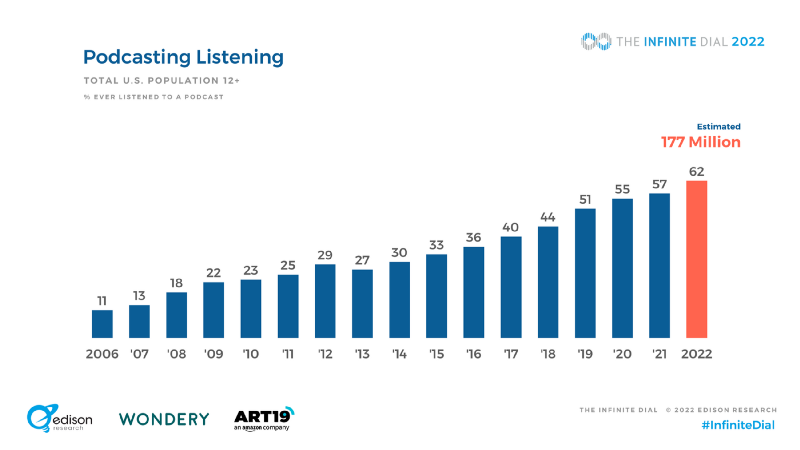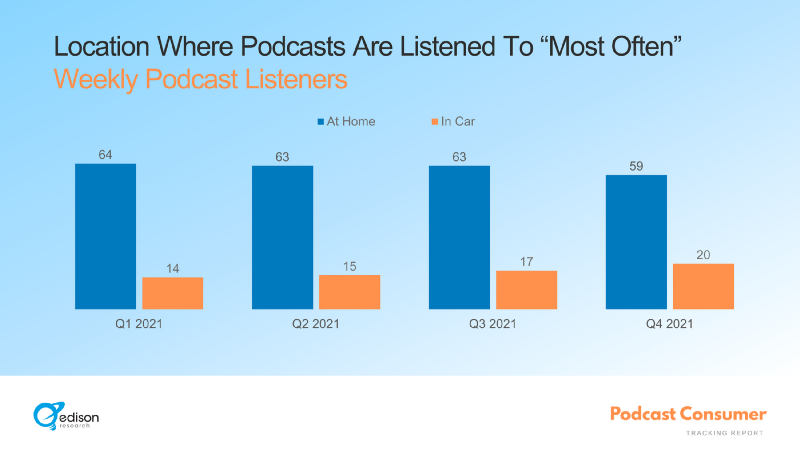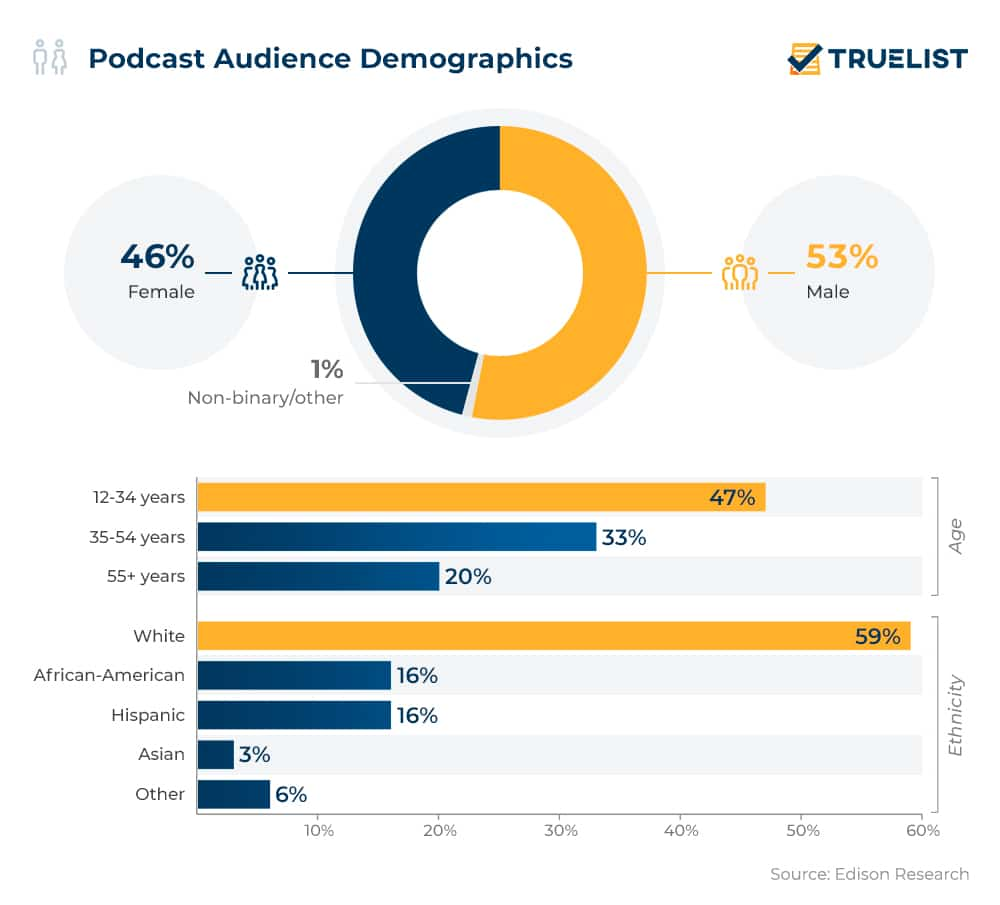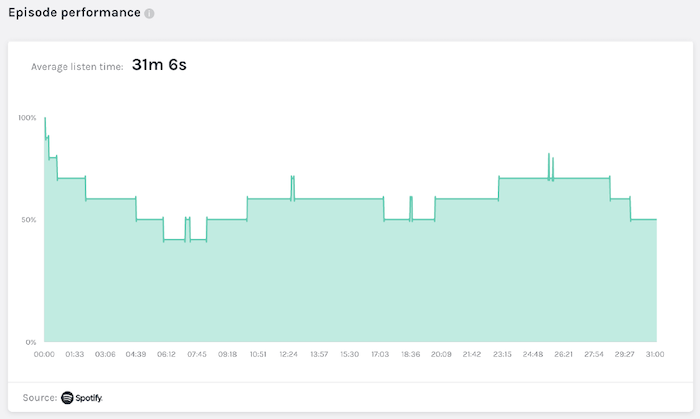Is podcast listener data important to know? Releasing a podcast can sometimes feel like a drop in the ocean in terms of listenership. With everyone from Conan O’Brien to Michelle Obama sitting behind the podcast microphone, creators need to use every advantage to get ahead.
And those hosts who know their listener data and to whom they are speaking have a definite advantage.
The podcast industry has grown significantly over the years. According to Podcast Insights, there are more than two million active podcasts in the podcast sphere, with over 48 million episodes as of April 2021.
With so many avenues available to record and release a podcast, these numbers are climbing daily. To get yourself noticed, you’ll need an understanding of your target audience, and market your content to them.

Whereas celebrity hosts can use their name to engage an audience, for others, it can be more challenging. Companies such as Wavve offer hosts the tools to amplify their content to new audiences on social media, for example.
There are other options available to grow your listener base. One of the most beneficial techniques is using listener data. All creators want to know who listens to their show, and better still, what audiences love about their show.
Once they have an understanding of both, podcasters can build upon this listener interaction. Knowing your audience inside and out provides you with the tools to grow and target new listeners.
In this post, we’ll help you define who your ideal listener persona is and how you can use this data to attract new audiences.
Why zeroing in on your podcast listener data is important
As with all successful ventures, having a clear idea of who your target audience is will lead to much better engagement. While it’s easy to get carried away recording your first podcast, creators need to remember who the content is actually for.
It’s why businesses do market tests before launching a product. If there isn’t a market for a product, how will it be a success? The same goes for podcasts. Listeners will engage with a podcast if it appeals to their needs and values.
With so many podcasts available, listeners have an endless amount of content at their fingertips. It’s up to you to make them decide that your podcast is worthwhile.

But how do you do that? Simply put, the answer lies in podcast listener data. Podcast analytics provide an analysis of listener data that gives podcasters an insight into their audience. All of this data allows them to measure how their content is landing with their listeners.
Establishing a listener persona
Once you have established a listener persona, your content will become naturally more focused and relevant. And depending on your podcast topic, your audience will either be very niche or very broad in scope.
Both audiences have their advantages. For example, the number of listeners interested in topics such as Apache Hive vs. Apache Spark may be small, but these genres will be sought after. To broaden in scope, the topic may be Database Management or IT Infrastructure. To go even broader, you have The Agile CTO podcast.
Broad topics reach as many people as possible. But they still need to be molded to attract specific listener demographics.
Defining your audience will be an ongoing process that will take time. Thankfully, by analyzing podcast data, you will be able to monitor your listener journey. Host statistics and demographic data will provide a clear picture of who your audience is.
This will give you the tools to adapt your podcast to appeal to your listener’s needs. Audiences respect value, whether that is informational or entertaining. Measuring how listeners interact with your podcast will make it easier to produce engaging content.
Moreover, giving your listeners what they want will ensure return visits — think of Joe Rogan talking about elk meat or the Office Ladies talking about pretzel day. These return visits will lead to word of mouth growth, listener recommendations, and listener loyalty.
Let’s take a clearer look at how you can identify your podcast listeners through data in the following section.
Investigate where your podcast listener data comes from
Podcast platforms will be able to provide some level of statistics and reports on your podcast. The data accumulated varies from platform to platform, but the main results will focus on:
- Listeners by podcast directories – directories include Apple Podcasts, Google Podcasts, Spotify, Deezer, etc. This will allow creators to understand what platforms are the most popular amongst their audience.
- Downloads per device – listener devices include computers, mobiles, tablets, etc. This data reveals to us how listeners are engaging with your podcast.
- Downloads per operating system – these systems include iOS, Windows, Android, etc.

As we can see from the above graph, there is a steady rise in “in car” listeners. This could be attributed to the lifting of pandemic restrictions, causing more people to travel back to work.
Using this podcast data, we can decipher whether listeners are multitasking using a mobile device, or listening at home on a computer. This information allows us to tailor our content to fit our audience’s needs.
If you know that your listeners are multitasking whilst engaging, you can create content that is lively and full of swift edits. If audiences are listening at home, you know that they’ll have more capacity to engage with what they are receiving, so your content can be well crafted and melodic.
Understanding what podcast hosting platform receives the most downloads means podcasters can optimize podcast episodes for search engine SEO. Your goal as a podcaster is to reach the widest audience possible, and tailoring your SEO to fit your audience will cast a wider digital net.
Another thing to note is that if creators know what operating system is most in use, they can alter their topics to fit audiences’ OS needs. An example of this would include mentioning Apple products or features in examples if the majority of your listeners are from an iOS system.
Listener Demographics
While we have established how audiences are engaging with your podcast, we also need to look at who is engaging. Data such as gender, age, and location will help podcasters cater to those who are listening.

By viewing your geographic podcast data, you can see where your audience comes from. This is helpful when addressing your audience and building a listener profile.
Let’s take the example of your podcast being popular in Canada. It would be worth focusing on popular topics that relate to the region to build upon engagement and boost podcast traffic.
Location, age, and gender will help hosts target the best advertisers and marketing decisions for their podcast. It will also provide a more well-rounded look at who their audience is and an idea of what topics will spark the most conversation.
These in-depth analytics eliminate guesswork and provide a more data-driven foundation.
Having a specific listener in mind will help you plan your episode content accordingly. Using topics that will be relatable will lead to more upvotes and podcast sharing.
These analytics allow you to form episodes that are far more likely to succeed with your listener landscape.
Average consumption data
Average consumption shows the performance of your podcast. The data breaks down how long audiences are engaging with your individual episodes and when they are tuning out.
These statistics are some of the most important analytics available to a creator. It helps paint an individual picture of listeners by evaluating their behaviors and habits.
It also reveals whether listeners are engaging to the end or skipping the podcast at certain times. Think of it as having direct feedback on what resonates with your audience and what doesn’t.

Imagine this consumption data as a neural network. A neural net transforms input data layers into output data layers. So, as a podcaster, you can use the input data of listener behavior and transfer it to your content output.
By studying where listeners are skipping an episode, you’ll be able to understand what content is most valuable to them. Completion rate data means you can learn about the needs of your listeners and the topics they value.
You’ll be able to check what topics are most popular amongst your target audience. It will also allow you to edit your content to meet listener satisfaction.
These tools will help creators settle on the micro-content vs. long-form content debate. If only a handful of listeners prefer lengthy content, it’s worth targeting the majority of listeners who favor concise edits. This will increase audience retention down the line.
Ask for podcast listener feedback
Now that you have data on where your listeners are from and an understanding of their behavior, it’s time to delve a little deeper. Information such as listener interests, values, and opinions will help to shape the content to meet their needs.
Getting involved in online communities means you can directly ask them for feedback, or even include a call for feedback in your podcast episodes or in your show notes. Some podcasts even provide a call-in phone number.
Letting your audience know that you want inspiration about future topics shows them that you are invested in the format. It will also garner a personal connection with your listeners. By taking their feedback, you are displaying that you are listening too.
Final thoughts
Creating a successful podcast takes time and effort. Having a helping hand in listener data is one way to guide podcasters along their journey. Accumulating audience data means hosts can work smartly rather than work blindly.
Using podcast listener data to their benefit is part of the podcasting process. These tools are available to all because they can help creators stand out in the sea of overflowing podcast episodes.
By developing audience awareness, hosts can develop specialized content that audiences want to hear.
Understanding your target audience is an ongoing pursuit. It’s important to have all communication channels open rather than ignoring them. If audiences can’t reach you, how can you expect to reach them?


